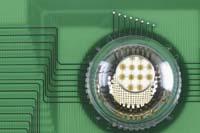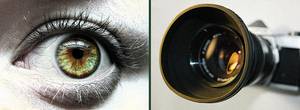Camera like eyes
2008/08/07 Carton Virto, Eider - Elhuyar Zientzia

The upper image camera is the size of a human eye, has the shape of a human eye and functions as a human eye. It has been developed at the University of Illinois and published in the latest issue of the journal Nature. Several experts consulted in Nature itself consider a spectacular advance. In fact, those who work in the field of optoelectronics had spent at least twenty years trying to develop something like that.
The camera, like the human eye, uses a curved lens to focus the image. In fact, the challenge was the development of photoreceptors -pixels- that did not break and deteriorated at the angle. Conventional cameras have flat surfaces, as typical silicon structures are broken. However, cameras capture the image through a curved lens, forcing them to use supplemental lenses to correct distortions from the curved source to the focus point.
The challenge has been overcome by this way at the University of Illinois. Silicon pixels have been connected by short metal threads and the network thus created has been collected in polymers (in a polyimide). This structure is curved in the compression and the structure itself absorbs the resulting mechanical tension. Therefore, pixels are not damaged (in the image the network is the one seen in the background).
To create the camera, this structure has been added to another domed structure. A network with pixels is able to stick it smoothly. They have achieved a very clean camera, with a lens on top and a network of pixels in the background. They have also posted a video showing how the camera looks.
The camera creator, John Rogers, believes that this system will facilitate the steps from the laboratory, as it is based on the material and technology that is already used.
Photo and video: Beckman Institute / University of Illinois

Gai honi buruzko eduki gehiago
Elhuyarrek garatutako teknologia





